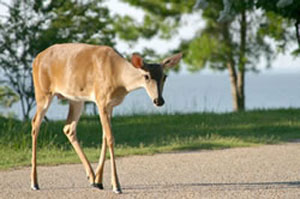

Deer-motor vehicle crashes up in 2007

Motor-vehicle crashes involving deer last year on North Carolina roadways jumped to 19,277, up from 17,236 in 2006. Of the total reported automobile crashes in North Carolina in 2007, deer were cited as a factor in 8.6 percent, up from 7.8 percent in 2006. Wake County topped the list with 1129 deer-related crashes. Other counties with high deer crashes include Guilford, Rockingham, Duplin and Pitt. There were 11 fatal crashes in 2007 related to deer compared to an average of approximately 6 over the last 3 years.
While a crash involving a deer can happen at any time, drivers should be particularly careful both in the early morning hours and the early evening hours. Almost 80 percent of deer-related crashes in 2007 occurred between the hours of 6 p.m. and 6 a.m.
White-tailed deer can be seen on the move around North Carolina roadways at any time of the year. Yet 48 percent of all deer-related crashes in North Carolina occurred during the months of October, November and December. For more information, please visit http://www.hsrc.unc.edu/news_room/2008-09-24_deer_08.cfm.
The UNC Highway Safety Research Center offers the following tips for lowering your risk of a crash with a deer.
- Slow down! In areas with a large deer population, or where there are deer warning signs, drivers should reduce their speed.
- Always wear your seat belt! It's your best protection from injuries in the event of a crash.
- Watch for eyes reflecting in your headlights. Try to look far down the road and scan the roadsides, especially when driving through field edges, heavily wooded areas, or posted deer crossing areas. The sooner you see a deer on or approaching a road, the better your chances of avoiding a crash.
- Remember that deer travel in herds. If you see one deer cross the road in front of you, don't assume that all is clear. Deer herds can be fairly large, and the animals often move one right behind the other.
- Do not place confidence in "deer whistles" or other "ultra-sonic" devices that claim to prevent deer collisions.
- Maintain control of your vehicle. It is important that you not lose control of your vehicle or veer into the path of an oncoming vehicle to avoid contact with an animal. Loss of control usually results in a more serious crash.
Figures reflect the total number of reported deer-related crashes. There is evidence that a great many more of these crashes occur than are reported to law enforcement agencies. The complete deer-motor vehicle crash data for all North Carolina counties is available at http://www.hsrc.unc.edu/safety_info/animal_vehicle/index.cfm.
The University of North Carolina Highway Safety Research Center
730 Martin Luther King Jr. Blvd, Suite 300 | Campus
Box 3430 | Chapel Hill, NC 27599-3430
Phone: 919.962.2203 | Fax: 919.962.8710
http://www.hsrc.unc.edu